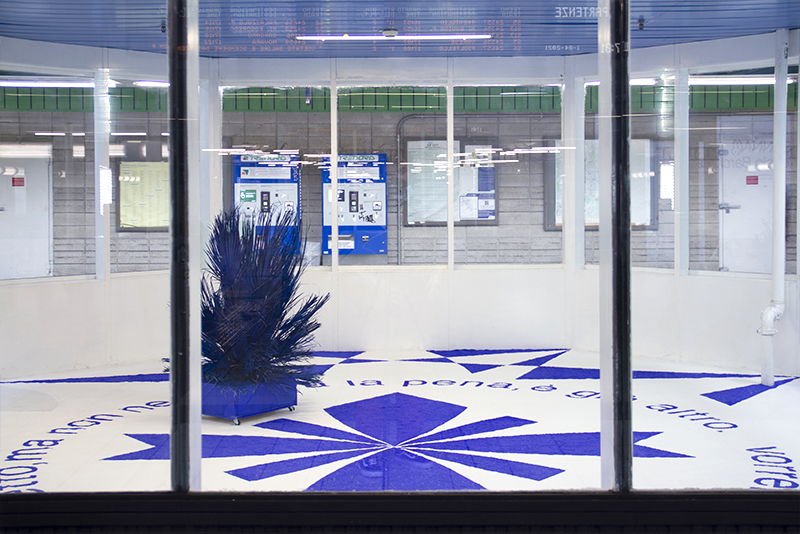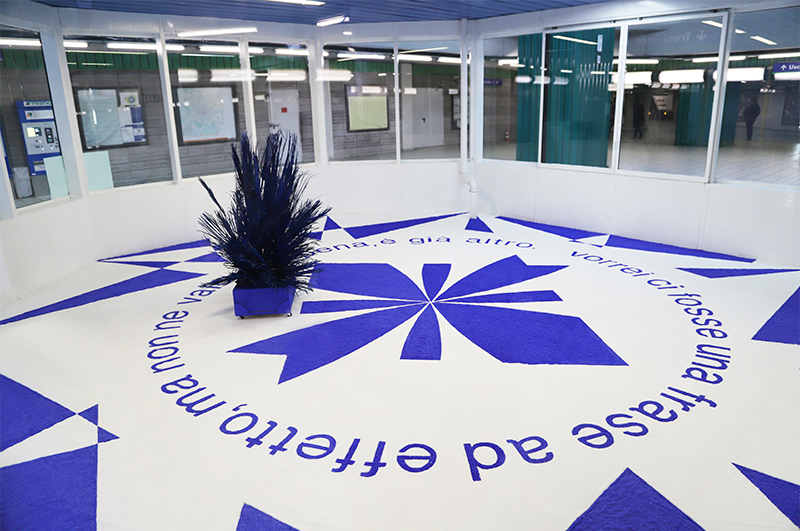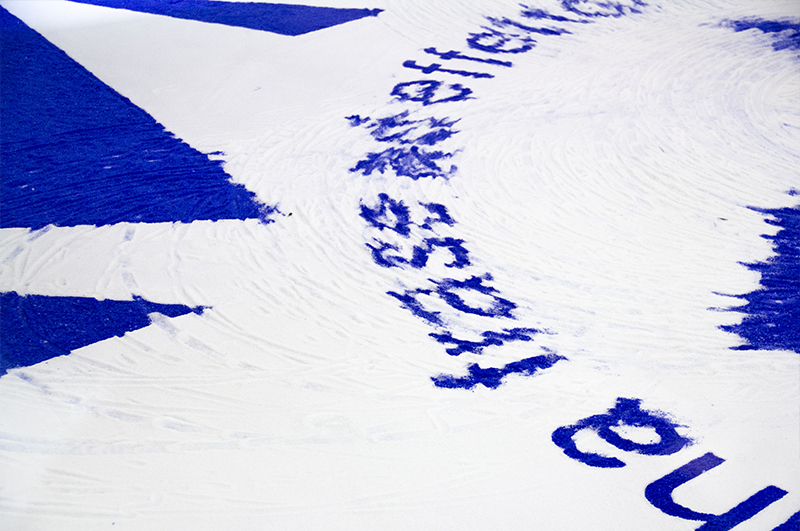OSANNA(!) -Testo di Balloon Project
1. interiez. [dal lat. tardo hosanna, gr. ὡσαννά, adattam. dell’ebr. hōshī delle Palme;̔ āh–nnā «salva!»]. – Voce ebraica di acclamazione e di preghiera che, nella tradizione evangelica viene rivolta dalla folla a Gesù in occasione della sua entrata trionfale a Gerusalemme nella domenica
2. imp. II persona di osannare /oza’n:are/ [der. di osanna] v. intr. [alzare grida di osanna e di evviva ■ cantare, gridare. v. tr. [manifestare venerazione per qualcuno] ≈ acclamare, celebrare, esaltare, glorificare, inneggiare.
(ad vocem osanna, in Enciclopedia Treccani.)
L’installazione site-specific è un’OSANNA(!) – da cui il titolo – che si genera, si evolve e si trasforma in altro, grazie al susseguirsi di azioni reiterate che creano un cambiamento non controllato e non prevedibile. OSANNA(!) riprende simboli, gerarchie e azioni tipiche delle cerimonie religiose. L’intervento sul tempo, sulla materia e sullo spazio è una dinamica costante nella ricerca di Alessio Barchitta, reinterpretata per quest’occasione in una rimodulazione del ruolo tra artista attore e opera agente. Ripercorrendo linee traiettorie date dal ricongiungimento delle colonne portanti della struttura con il suo centro, l’artista sparge sul pavimento del sale colorato di blu e di bianco e delinea un motivo geometrico dall’intersezione dei tracciati che, grazie all’alternanza dei due toni, danno origine ad una varietà di soluzioni. L’avvio casuale da parte di Barchitta di un dispositivo da lui creato, camuffato da foglie di palma blu, provoca un’interferenza e la distruzione parziale o totale del disegno dapprima costituito, portando via con sé anche la frase che campeggia al centro dello spazio.
“Vorrei ci fosse una frase ad effetto, ma non ne valeva la pena, è già altro”
Comincia una sorta di processione liturgica dove l’artista veste i panni dell’officiante. Entrambe le figure obbediscono a un sistema gerarchico e dogmatico, l’uno guidato dalle antiche consuetudini, l’altro dalle linee determinate dallo spazio. Nella liturgia di Alessio, tuttavia, viene a mancare la Fede che spinge i partecipanti in raccolta, il rischio che questi possano convertirsi in eretici passanti è alto. Se l’officiante e i fedeli non prendessero parte alla liturgia, compiendo ciascuno il proprio compito, questa non esisterebbe, parimenti, se non ci fosse l’artista, il curatore e il pubblico, la mut-azione voluta da Barchitta non si realizzerebbe. Per mut-azione s’intende innanzitutto il costante ma incontrollato cambiamento fisico dell’opera che, da ordinato intreccio di linee, perde ogni rigore formale. In secondo luogo, il termine indica la messa in discussione della figura dell’artista da parte dello stesso Barchitta: non più spinto dalla creatività bensì guidato dall’automatismo, espresso nel tracciato delle linee e nella sostituzione di sé con il dispositivo. All’artista, dunque, appartiene il disegno generale dell’opera ma non il suo effettivo risultato finale.
Quindi l’artista si trasforma in tecnico, in semplice esecutore, che cede la sua autorialità a vantaggio di una macchina, un automa vegetale. La macchina, pur essendo stata creata da Alessio all’interno di OSANNA(!), agisce in modo caotico e distruttivo sul progetto, a livello sia teorico sia formale.
Qual è dunque il criterio fondamentale per definire una creazione “opera d’arte”, quando la sua forma, paradossalmente, è un “residuo”? Il dubbio è lecito in un’epoca in cui tutto ormai è potenzialmente arte, quando propriamente contestualizzata dal luogo in cui è esposta. Il contesto qui è spazioSERRA che non è una galleria, né un museo, tuttavia riconosciamo come artistico il suo contenuto. Pertanto, se il luogo risulta indifferente, sarà il valore formale a legittimare l’opera in quanto tale? In realtà, OSANNA(!) si trasforma di continuo e non raggiunge mai l’integrità. Nonostante la simmetria del disegno minuziosamente tracciato e la perizia con cui Alessio ha creato la macchina, l’artista nega l’intrattenimento dato dall’esposizione del suo processo creativo, programmandone il sacrificio. Così l’unico elemento superstite della liturgia dell’arte è la partecip- azione del pubblico.
Caro pubblico,
cosa porterai con te di questa venerazione mutante? Tornando alle accezioni di OSANNA(!), qualora la distruzione del disegno abbia suscitato il tuo sconcerto e avrai provato a darle un significato dopo la sua morte, potrai dire di aver partecipato alla mostra in qualità di fedele, di aver contribuito alla salvezza, alla resurrezione dell’opera in te. Se infatti, l’esperienza estetica è intesa come αÏσθησις cioè «capacità di sentire» o «sensibilità» avrai vissuto l’opera come un’esperienza personale, seppur perturbante e traumatica. Al contrario, se non hai percepito il trauma, la tua esperienza sarà stata an-estetica, e avrai partecipato alla mostra in qualità di spettatore, contribuendo all’ulteriore celebrazione del sistema dell’arte. Non preoccuparti, infine, per quel che hai o non hai provato, in qualunque caso è già altro… come il foglio blu è già la tua personalissima palma.
OSANNA(!) – text by Balloon Project
Hosanna, in modern speech and liturgical usage, a cry of praise to God. It has acquired this meaning through the assumption that it was so meant by the multitude that hailed Jesus on Palm Sunday (Mark 11:9). If it was, it must already have become a Jewish liturgical cry rather far removed from its original meaning—the word is a Greek transliteration of the Hebrew hôshîʿah-nnaʾ “Save, (we) beseech Thee!” It meant, thus, entreaty, not praise (as inPsalms 118:25). If the crowd still knew its original meaning, they must have been addressing it to Jesus as the newDavid, as a plea for political salvation.
(Encyclopedia Britannica)
The site-specific installation is an OSANNA(!) (hosanna) – hence the title – that is generated, evolves and transforms itself into something else, thanks to the succession of repeated actions that create an uncontrolled and unpredictable change. OSANNA(!) recalls symbols, hierarchies and actions typical of religious ceremonies. The action on time, on matter and on space is a constant dynamic in Alessio Barchitta’s research, reinterpreted for this occasion in a remodeling of the relation between artist as actor and artwork as agent. Following the trajectories given by the rejoining of the supporting columns of the structure with its center, the artist spreads on the floor some blue and white salt and outlines a geometric pattern from the intersection of the lines which, thanks to the alternation of the two tones, give rise to a variety of solutions. Barchitta is going to activate a device he created, camouflaged by blue palm leaves, which causes interference and the partial or total destruction of the first design, taking away with it also the phrase that stands out in the center of the space.
“vorrei ci fosse una frase ad effetto, ma non ne valeva la pena, è già altro”
(I wish there was a catch phrase, but it wasn’t worth it, it’s already something else)
A sort of liturgical procession begins and the artist takes on the role of the officiant. Both figures obey a hierarchical and dogmatic system, one guided by ancient customs, the other by lines determined by the space. In Alessio’s liturgy, however, the Faith that pushes the participants to gather is lacking, the risk that they can become heretic passers-by is high. If the officiant and the faithful did not take part in the liturgy, each carrying out their own task, this would not exist; likewise, if there were not the artist, the curator and the public, the mut-action desired by Barchitta would not take place. By mut-action we mean above all the constant but uncontrolled physical change of the work which, from a neat woven of lines, loses all formal rigor. Secondly, the term indicates the questioning of the figure of the artist by Barchitta himself: the artist is no longer driven by creativity but guided by automatism, expressed in the tracing of the lines and in the replacement of himself with the device. Therefore, the general design of the work belongs to the artist but not its actual final result.
The artist becomes a technician, a simple performer, who waves his authorship in favour of a machine, a plant automaton. The machine, despite having been created by Alessio for OSANNA(!), acts in a chaotic and destructive way on the project, both theoretically and formally.
What is the fundamental criterion for defining a creation as a “work of art”, when its shape, paradoxically, is a “residue”? Doubt is legitimate in an era in which everything is now potentially art, when properly contextualized by the place where it is exhibited. The context here is spazioSERRA, which is not a gallery or a museum, however we recognize its content as artistic. Therefore, if the place does not matter, will the formal value legitimize the work as such? OSANNA(!) is actually constantly transformed and never reaches integrity. Despite the symmetry of the meticulously traced drawing and the skill with which Alessio created the machine, the artist denies the entertainment given by the exhibition of his creative process, planning its sacrifice. Thus, the only surviving element of the liturgy of art is the particip-action of the public.
Dear audience,
what will you bring with you of this mutant veneration? Returning to the meanings of OSANNA(!), if the destruction of the drawing has aroused your bewilderment and you have tried to give it meaning after his death, you can say that you have participated in the exhibition as a faithful, that you have contributed to the salvation, to the resurrection of the work in you. In fact, if the aesthetic experience is understood as αἴσϑησις that is “ability to feel” or “sensitivity” you will have lived the work as a personal experience, albeit perturbing and traumatic. On the contrary, if you have not perceived the trauma, your experience will have been anesthetic, and you will have participated in the exhibition as a spectator, contributing to the further celebration of the art system. Finally, do not worry about what you have or have not tried, in any case it is already something else…













sale, foglie di palma, dispositivo meccanico
dimensione ambientale
2021
